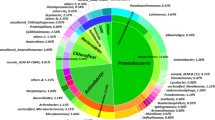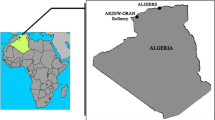Abstract
Petroleum polycyclic aromatic hydrocarbons (PAHs) are health risks to human, as they can be toxic, mutagenic and carcinogenic. As the Kingdom of Saudi Arabia is one of the major petroleum-producing countries, they inevitably suffer from worsening this environmental problem. Therefore, removal of these compounds from the environment is a necessity for ensuring human health. In this study, 54 bacterial isolates were obtained by enrichment techniques from oil-contaminated soil samples. Out of them, seven gram-negative bacterial strains, KKU-J1, KKU-J2, KKU-J4, KKU-J7, KKU-J9, KKU-J14 and KKU-J17, exhibiting ability for petroleum PAHs degradation were selected. The isolates showing the highest growth during screening as demonstrated by the increase in their optical densities (OD600) and a concentration-dependent growth in all examined PAH compounds that grew in it, with strains KKU-J2, KKU-J7 and KKU-J17 were the best. The highest optimum growth rate of \({0.333 \pm 0.0, 0.364 \pm 0.016}\) and \({0.357 \pm 0.004 ({\rm OD}_{600})}\) was recorded for the strains KKU-J2, KKU-J7 and KKU-J17, respectively, when the level of phenanthrene was 100 mg/l. On the other hand, strain KKU-J2 was found to be the best one (\({0.413 \pm 0.0}\)) when the level of naphthalene was 100 mg/l. Molecular identification of the selected isolates was detected based on 16S rRNA gene amplification and partial sequence determination. Alignment results and the comparison of 16S rRNA gene sequences of the isolates to the 16S rRNA gene sequences available in GenBank database, as well as the phylogenetic analysis, confirmed the accurate position of the isolates as Sphingomonas paucimobilis KKU-J1, Pseudomonas alcaligenes KKU-J2, Micrococcus antarcticus KKU-J4, Arthrobacter oxydans KKU-J7, Stenotrophomonas rhizophila KKU-J9, Kocuria rhizophila KKU-J14 and Shinella zoogloeoides KKU-J17. RAPD–PCR fingerprinting was carried out for the seven isolates, and the DNA patterns revealed that there is no correlation between the RAPD profile and geographic origin sites where these isolates were collected from. This study indicates that the contaminated soil samples contain a diverse population of PAH-degrading bacteria, and the use of soil-associated microorganisms could be recommended for PAHs bioremediation in the environment.
Similar content being viewed by others
References
Aitken M.D., Stringfellow W.T., Nagel R.D., Kazunga C., Chen S.-H.: Characteristics of phenanthrene-degrading bacteria isolated from soils contaminated with polycyclic aromatic hydrocarbons. Can. J. Microbiol. 44, 743–752 (1998)
Molina-Barahona L., Rodrıguez-Vázquez R., Hernández-Velasco M., Vega-Jarquın C., Zapata-Pérez O., Mendoza-Cantú A., Albores A.: Diesel removal from contaminated soils by biostimulation and supplementation with crop residues. Appl. Soil Ecol. 27, 165–175 (2004)
Mastrangelo G., Fadda E., Marzia V.: Polycyclic aromatic hydrocarbons and cancer in man. Environ. Health Perspect. 104, 1166–1170 (1996)
Goldman R., Enewold L., Pellizzari E., Beach J.B., Bowman E.D., Krishnan S.S., Shields P.G.: Smoking increases carcinogenic polycyclic aromatic hydrocarbons in human lung tissue. Cancer Res. 61, 6367–6371 (2001)
Khan S., Cao Q., Lin A.-J., Zhu Y.-G.: Concentrations and bioaccessibility of polycyclic aromatic hydrocarbons in wastewater-irrigated soil using in vitro gastrointestinal test. Environ. Sci. Pollut. Res. 15, 344–353 (2008)
Preuss R., Angerer J., Drexler H.: Naphthalene—an environmental and occupational toxicant. Int. Arch. Occup. Environ. Health 76, 556–576 (2003)
Surridge, A.K.J.; Wehner, F.C.; Cloete, T.E.: Bioremediation of polluted soil. In: Singh, A.; Kuhad, R.C.; Ward, O.P. (eds.) Advances in Applied Bioremediation, pp. 103-121, Springer, Berlin, (2009) ISBN 978-3-540-89620-3
Couling N.R., Towell M.G., Semple K.T.: Biodegradation of PAHs in soil: influence of chemical structure, concentration and multiple amendment. Environ. Pollut. 158, 3411–3420 (2010)
Hesham, A.; Mawad, A.M.; Mostafa, Y.M.; Shoreit, A.: Biodegradation ability and catabolic genes of petroleum-degrading Sphingomonas koreensis strain ASU-06 isolated from Egyptian oily soil. BioMed Res. Int. 2014, 127674 (2014). doi:10.1155/2014/127674
Hesham A., Mawad A.M., Mostafa Y.M., Shoreit A.: Study of enhancement and inhibition phenomena and genes relating to degradation of petroleum polycyclic aromatic hydrocarbons in isolated bacteria. Microbiology 83, 599–607 (2014)
Hesham A., Wang Z., Zhang Y., Zhang J., Lv W., Yang M.: Isolation and identification of a yeast strain capable of degrading four and five ring aromatic hydrocarbons. Ann. Microbiol. 56, 109–112 (2006)
Hesham A.E.L.: New safety and rapid method for extraction of genomic DNA from bacteria and yeast strains suitable for PCR amplifications. J. Pure Appl. Microbiol. 8, 383–388 (2014)
Lane D.J.: 16S/23S rRNA sequencing. In: Stackebrandt, E., Goodfellow, M. (eds.) Nucleic acid Techniques in Bacterial systematics, pp. 115–175. Wiley, New York (1991)
Martorell, R.; Behrman, J.R.; Flores, R.; Stein, A.D.: Rationale for a follow-up study focusing on economic productivity. Food Nut. Bull. 26(2), S5–S14 (2005)
Yeh, F.C.; Boyle, T.J.B.: Population genetic analysis of codominant and dominant markers and quantitative traits. Belg. J. Bot. 129, 157–163 (1997)
Hunter P.R., Gaston M.A.: Numerical index of the discriminatory ability of typing systems: an application of Simpson’s index of diversity. J. Clin. Microbiol. 26, 2465–2466 (1988)
Aitken M.D., Stringfellow W.T., Nagel R.D., Kazunga C., Chen S.-H.: Characteristics of phenanthrene-degrading bacteria isolated from soils contaminated with polycyclic aromatic hydrocarbons. Can. J. Microbiol. 44, 743–752 (1998)
Gordon L., Dobson A.D.W.: Fluoranthene degradation in Pseudomonas alcaligenes PA-10. Biodegradation 12, 393–400 (2001)
Arulazhagan P., Vasudevan N., Yeom I.: Biodegradation of polycyclic aromatic hydrocarbon by a halotolerant bacterial consortium isolated from marine environment. Environ. Sci. Technol. 7, 639–652 (2010)
Abd-El-Haleem D., Moawad H., Zaki E.A., Zaki S.: Molecular characterization of phenol-degrading bacteria isolated from different Egyptian ecosystems. Microbiol 43, 217–224 (2002)
Franzetti L., Scarpeluni M.: Characterisation of Pseudomonas spp. isolated from foods. Ann. Microbiol. 57, 39–47 (2007)
Zhang M., Liu W., Nie X., Li C., Gu J., Zhang C.: Molecular analysis of bacterial communities in biofilms of a drinking water clearwell. Microbes Environ. 27, 443–448 (2012)
Panda S., Bandyopadhyay P.K., Chatterjee S.N.: Characterization of Pseudomonas aeruginosa PB112 (JN996498) isolated from infected Labeo bata (Hamilton) by 16S rRNA gene sequence analysis and fatty acid methyl ester (FAME) analysis. Afr. J. Biotechnol. 12, 400–405 (2013)
Narasimhulu K., Setty Y.P.: Isolation and characterization of naphthalene degrading bacteria from soils in Warangal. Int. J. Appl. Biol. Pharm. Technol. 2, 94–103 (2011)
John R., Essien J., Akpan S., Okpokwasili G.: Polycyclic aromatic hydrocarbon-degrading bacteria from aviation fuel spill site at Ibeno, Nigeria. Bull. Environ. Contam. Toxicol. 88, 1014–1019 (2012)
Rahman K.S.M., Banat I.M., Thahira J., Thayumanavan T., Lakshmanaperumalsamy P.: Bioremediation of gasoline contaminated soil by a bacterial consortium amended with poultry litter, coir pith and rhamnolipid biosurfactant. Bioresour. Technol. 81, 25–32 (2002)
Leahy J.G., Tracy K.D., Eley M.H.: Degradation of mixtures of aromatic and chloroaliphatic hydrocarbons by aromatic hydrocarbon-degrading bacteria. FEMS Microbiol. Ecol. 43, 271–276 (2003)
Stapleton R.D., Bright N.G., Sayler G.S.: Catabolic and genetic diversity of degradative bacteria from fuel-hydrocarbon contaminated aquifers. Microbial. Ecol. 39, 211–221 (2000)
Ntougias S., Melidis P., Navrozidou E., Tzegkas F.: Diversity and efficiency of anthracene-degrading bacteria isolated from a denitrifying activated sludge system treating municipal wastewater. Int. Biodeterior. Biodegrad. 97, 151–158 (2015)
Juhasz A.L., Stanley G., Britz M.: Metabolite repression inhibits degradation of benzo [a] pyrene and dibenz [a, h] anthracene by Stenotrophomonas maltophilia VUN 10,003. J. Ind. Microbiol. Biotechnol. 28, 88–96 (2002)
Ahmed R.Z., Ahmed N., Gadd G.M.: Isolation of two Kocuria species capable of growing on various polycyclic aromatic hydrocarbons. Afr. J. Biotechnol 9, 3611–3617 (2010)
Peng H., Yin H., Deng J., Ye J.-S., Chen S.-N., He B.-Y., Zhang N.: Biodegradation of Benzo[a]pyrene by Arthrobacter oxydans B4. Pedosphere 22, 554–561 (2012)
Al-Thani R.F., Abd-El-Haleem D.A., Al-Shammri M.: Isolation and characterization of polyaromatic hydrocarbons-degrading bacteria from different Qatari soils. Afr. J. Microbiol. Res 3, 761–766 (2009)
Desai A.M., Autenrieth R.L., Dimitriou-Christidis P., McDonald T.J.: Biodegradation kinetics of select polycyclic aromatic hydrocarbon (PAH) mixtures by Sphingomonas paucimobilis EPA505. Biodegradation 19, 223–233 (2008)
Guo C., Dang Z., Wong Y., Tam N.F.: Biodegradation ability and dioxgenase genes of PAH-degrading Sphingomonas and Mycobacterium strains isolated from mangrove sediments. Int. Biodeterior. Biodegrad. 64, 419–426 (2010)
Molnar E., Baude A., Richmond S., Patel P., Somogyi P., McIlhinney R.: Biochemical and immunocytochemical characterization of antipeptide antibodies to a cloned GluR1 glutamate receptor subunit: cellular and subcellular distribution in the rat forebrain. Neuroscience 53, 307–326 (1993)
Thanos M., Schonian G., Meyer W., Schweynoch C., Graser Y., Mitchell T., Presber W., Tietz H.: Rapid identification of Candida species by DNA fingerprinting with PCR. J. Clin. Microbiol. 34, 615–621 (1996)
Cancilla M.R., Powell I.B., Hillier A.J., Davidson B.E.: Rapid genomic fingerprinting of Lactococcus lactis strains by arbitrarily primed polymerase chain reaction with 32P and fluorescent labels. Appl. Environ. Microbiol. 58, 1772–1775 (1992)
Cocconcelli P.S., Porro D., Galandini S., Senini L.: Development of RAPD protocol for typing of strains of lactic acid bacteria and enterococci. Lett. Appl. Microbiol 21, 376–379 (1995)
Drake L.R., Lin S., Rayson G.D., Jackson P.J.: Chemical modification and metal binding studies of Datura innoxia. Environ. Sci. Technol 30, 110–114 (1996)
Migheli Q., Briatore E., Garibaldi A.: Use of random amplified polymorphic DNA (RAPD) to identify races 1, 2, 4 and 8 of Fusarium oxysporum f. sp. dianthi in Italy. Eur. J. Plant Pathol. 104, 49–57 (1998)
Author information
Authors and Affiliations
Corresponding author
Rights and permissions
About this article
Cite this article
Hesham, A.EL., Alrumman, S.A. & Al-Amari, J.A. 16S rDNA Phylogenetic and RAPD–PCR Analyses of Petroleum Polycyclic Aromatic Hydrocarbons-Degrading Bacteria Enriched from Oil-Polluted Soils. Arab J Sci Eng 41, 2095–2106 (2016). https://doi.org/10.1007/s13369-015-1843-2
Received:
Accepted:
Published:
Issue Date:
DOI: https://doi.org/10.1007/s13369-015-1843-2




